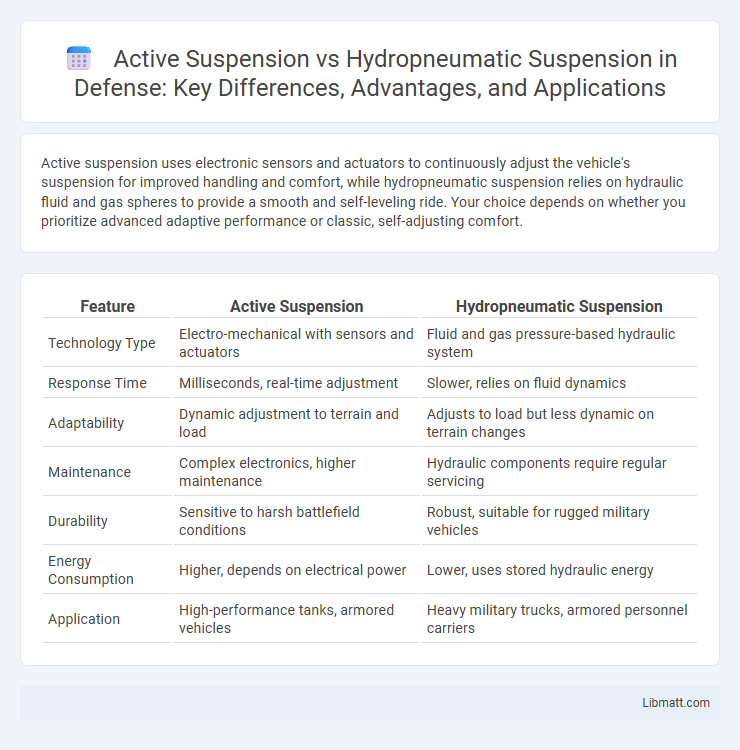Active suspension uses electronic sensors and actuators to continuously adjust the vehicle's suspension for improved handling and comfort, while hydropneumatic suspension relies on hydraulic fluid and gas spheres to provide a smooth and self-leveling ride. Your choice depends on whether you prioritize advanced adaptive performance or classic, self-adjusting comfort.
Table of Comparison
| Feature | Active Suspension | Hydropneumatic Suspension |
|---|---|---|
| Technology Type | Electro-mechanical with sensors and actuators | Fluid and gas pressure-based hydraulic system |
| Response Time | Milliseconds, real-time adjustment | Slower, relies on fluid dynamics |
| Adaptability | Dynamic adjustment to terrain and load | Adjusts to load but less dynamic on terrain changes |
| Maintenance | Complex electronics, higher maintenance | Hydraulic components require regular servicing |
| Durability | Sensitive to harsh battlefield conditions | Robust, suitable for rugged military vehicles |
| Energy Consumption | Higher, depends on electrical power | Lower, uses stored hydraulic energy |
| Application | High-performance tanks, armored vehicles | Heavy military trucks, armored personnel carriers |
Introduction to Suspension Systems
Active suspension systems use sensors and actuators to continuously adjust the vehicle's suspension, enhancing ride comfort and handling by responding in real-time to road conditions. Hydropneumatic suspension combines hydraulic fluid and compressed gas to provide a smooth, self-leveling ride with adjustable stiffness and height, often found in luxury vehicles. Your choice between these depends on whether you prioritize advanced adaptability of active suspension or the refined comfort and simplicity offered by hydropneumatic systems.
Overview of Active Suspension
Active suspension systems use electronic sensors and actuators to continuously adjust the suspension in real-time, providing superior ride comfort and handling by adapting to road conditions and driving dynamics. Unlike hydropneumatic suspension, which relies on pressurized fluid and gas to absorb shocks and maintain vehicle height, active suspension offers precise control over each wheel's movement to minimize body roll and improve stability. Your vehicle can benefit from enhanced responsiveness and smoother performance with active suspension technology.
Overview of Hydropneumatic Suspension
Hydropneumatic suspension utilizes pressurized hydraulic fluid and gas-filled spheres to provide a self-leveling, smooth ride by automatically adjusting to road conditions and vehicle load. This system excels in maintaining consistent ride height and damping, improving comfort and handling without the need for complex electronic controls found in active suspension. Its ability to absorb road shocks and maintain stability makes it popular in luxury and off-road vehicles where enhanced ride quality is essential.
Key Components and Mechanisms
Active suspension systems rely on sensors, actuators, and electronic control units to continuously adjust the suspension in real time for optimal ride comfort and handling. Hydropneumatic suspension uses a combination of hydraulic fluid and compressed gas enclosed in spheres to provide self-leveling and adaptive damping without electronic intervention. Your choice between these systems will depend on the desired balance of complexity, responsiveness, and maintenance requirements.
Performance and Ride Quality Comparison
Active suspension systems use electronic sensors and actuators to continuously adjust damping and stiffness, resulting in superior handling and ride comfort by minimizing body roll and road vibrations. Hydropneumatic suspension employs pressurized fluid and gas to provide self-leveling and smooth cushioning, excelling in maintaining ride height and absorbing large impacts for enhanced comfort. While active suspension offers dynamic adaptability for precise performance in varied conditions, hydropneumatic suspension prioritizes consistent ride quality and load leveling, making each suitable for different driving demands.
Handling and Stability Differences
Active suspension systems use electronic sensors and actuators to continuously adjust the stiffness and damping of the suspension, improving handling and stability by minimizing body roll and maintaining tire contact. Hydropneumatic suspension relies on pressurized fluid and gas to provide a smooth ride and self-leveling capabilities, but may not respond as quickly to dynamic driving conditions as active systems. Your choice between the two impacts vehicle control precision, with active suspension offering superior adaptability for enhanced handling on varied terrains.
Maintenance and Reliability
Active suspension systems typically require more frequent maintenance due to their complex electronic components and sensors, which can be prone to failure over time. Hydropneumatic suspension, known for its simpler hydraulic design, generally offers higher reliability with less intensive upkeep, though it may still require periodic checks for fluid leaks and component wear. Overall, hydropneumatic suspension tends to provide greater durability in harsh conditions, while active suspension demands more careful and regular servicing to maintain optimal performance.
Cost and Complexity Analysis
Active suspension systems involve advanced sensors, electronic control units, and actuators, leading to higher initial costs and increased complexity in design and maintenance compared to hydropneumatic suspension systems. Hydropneumatic suspensions rely on hydraulic fluid and gas-filled spheres to provide a smoother ride with fewer electronic components, resulting in lower manufacturing and repair expenses. The intricate technology in active suspensions requires specialized diagnostics and skilled labor, which further drives up long-term operational costs relative to the more straightforward hydropneumatic setup.
Applications and Use Cases
Active suspension systems are widely used in high-performance sports cars and luxury vehicles to enhance ride comfort and handling by continuously adjusting damping forces based on road conditions and driving dynamics. Hydropneumatic suspension finds extensive application in heavy-duty trucks, off-road vehicles, and classic Citroen models, offering superior load leveling, self-levelling capabilities, and smooth ride quality over rough terrain. Your choice between these systems depends on whether you prioritize adaptive real-time performance or robust, maintenance-friendly load management in specialized environments.
Future Trends in Suspension Technology
Active suspension systems leverage advanced sensors and real-time data processing to adapt to road conditions dynamically, promising smoother rides and improved vehicle control. Hydropneumatic suspension remains valued for its self-leveling capabilities and comfort but faces limitations in adaptability compared to electronic systems. Future trends emphasize integration of AI-driven active suspension technologies, enhancing responsiveness and energy efficiency tailored to your driving needs.
active suspension vs hydropneumatic suspension Infographic

 libmatt.com
libmatt.com